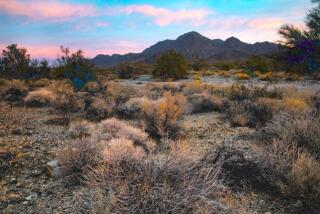Federal protection sought for Joshua trees
- Share via
Drought, more frequent wildfires and rising temperatures due to climate change are upsetting the delicate balance between life and death conditions for Joshua Tree National Park’s peculiar namesake plant.
Many Joshua trees in the region have not reproduced in decades. If warmer, drier conditions continue, scientific modeling suggests the symbols of California’s deserts will lose 90% of their range in the 800,000-acre park and surrounding terrain by the end of the century.
As part of an effort to reverse the trend, the conservation group WildEarth Guardians on Wednesday petitioned the U.S. Fish and Wildlife Service to list the species as threatened under the Endangered Species Act.
“Joshua trees need our help,” Taylor Jones, a spokeswoman for the nonprofit, said in an interview. “Our petition seeking federal protections for them is a way of extending a helping hand.”
Some conservationists have proposed translocation efforts and habitat restoration programs to save the trees from widespread extirpation.
In the meantime, UC Riverside ecologist Cameron Barrows, with funding from federal wildlife officials, is assessing the effects of climate change on the park’s 2.5 million Joshua trees and species that rely on them including yucca moths, termites, ants, desert night lizards, kangaroo rats and birds including ladder-backed woodpeckers.
Joshua trees are also cultural mainstays for movies, fashion shoots, advertising campaigns and wedding ceremonies. The one that adorned the cover of U2’s 1987 album “The Joshua Tree” became a pilgrimage site for fans from around the world.
Yucca brevifolia isn’t actually a tree, it’s a succulent that grows up to 40 feet high, lives more than 200 years and blooms sporadically.
It was named for the biblical figure Joshua by a band of Mormons traveling through the Cajon Pass back to Utah in 1857. They imagined the trees as prophets, their outstretched limbs pointing the way to their promised land.
During the 1980s, an estimated 200,000 Joshua trees were replaced by development in desert boom towns. Many more were removed later to make way for renewable energy facilities.
NEWSLETTER: Get the day’s top headlines from Times Editor Davan Maharaj >>
In the 1990s, heavy rains triggered explosive growth of exotic grasses among the trees. Feeding off nitrogen-laden smog, the grasses left Joshua tree forests vulnerable to large-scale brush fires such as one that charred 14,000 acres in 1999.
In a collaborative effort, the park, the U.S. Fish and Wildlife Service and a research team led by Barrows are trying to create a baseline of data to help guide conservation decisions as Joshua tree forests retreat to higher elevations that are wetter and cooler.
Follow me @LouisSahagun for more fascinating stories.
MORE FROM SCIENCE
Life on Mars? Newly discovered water is a strong sign, NASA says
How the Syrian crisis is particularly deadly for women and children
Memory of JPL’s Claudia Alexander lives on -- atop a peak on Rosetta’s comet







